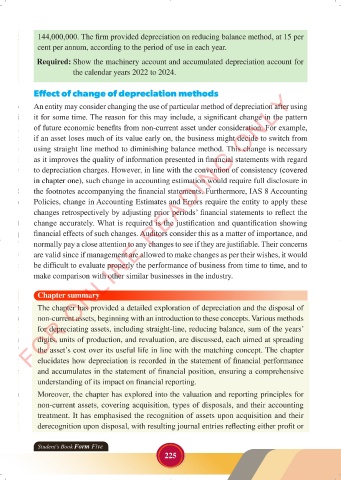Page 238 - Accountancy_F5
P. 238
144,000,000. The firm provided depreciation on reducing balance method, at 15 per
cent per annum, according to the period of use in each year.
Required: Show the machinery account and accumulated depreciation account for
the calendar years 2022 to 2024.
FOR ONLINE READING ONLY
Effect of change of depreciation methods
An entity may consider changing the use of particular method of depreciation after using
it for some time. The reason for this may include, a significant change in the pattern
LANGUAGE EDITING
of future economic benefits from non-current asset under consideration. For example,
if an asset loses much of its value early on, the business might decide to switch from
LANGUAGE EDITING
using straight line method to diminishing balance method. This change is necessary
as it improves the quality of information presented in financial statements with regard
to depreciation charges. However, in line with the convention of consistency (covered
in chapter one), such change in accounting estimation would require full disclosure in
the footnotes accompanying the financial statements. Furthermore, IAS 8 Accounting
Policies, change in Accounting Estimates and Errors require the entity to apply these
changes retrospectively by adjusting prior periods’ financial statements to reflect the
change accurately. What is required is the justification and quantification showing
financial effects of such changes. Auditors consider this as a matter of importance, and
normally pay a close attention to any changes to see if they are justifiable. Their concerns
are valid since if management are allowed to make changes as per their wishes, it would
be difficult to evaluate properly the performance of business from time to time, and to
make comparison with other similar businesses in the industry.
Chapter summary
The chapter has provided a detailed exploration of depreciation and the disposal of
non-current assets, beginning with an introduction to these concepts. Various methods
for depreciating assets, including straight-line, reducing balance, sum of the years’
digits, units of production, and revaluation, are discussed, each aimed at spreading
the asset’s cost over its useful life in line with the matching concept. The chapter
elucidates how depreciation is recorded in the statement of financial performance
and accumulates in the statement of financial position, ensuring a comprehensive
understanding of its impact on financial reporting.
Moreover, the chapter has explored into the valuation and reporting principles for
non-current assets, covering acquisition, types of disposals, and their accounting
treatment. It has emphasised the recognition of assets upon acquisition and their
derecognition upon disposal, with resulting journal entries reflecting either profit or
Student’s Book Form Five
225
23/06/2024 17:36
ACCOUNTANCY_DUMMY_23 JUNE.indd 225
ACCOUNTANCY_DUMMY_23 JUNE.indd 225 23/06/2024 17:36

